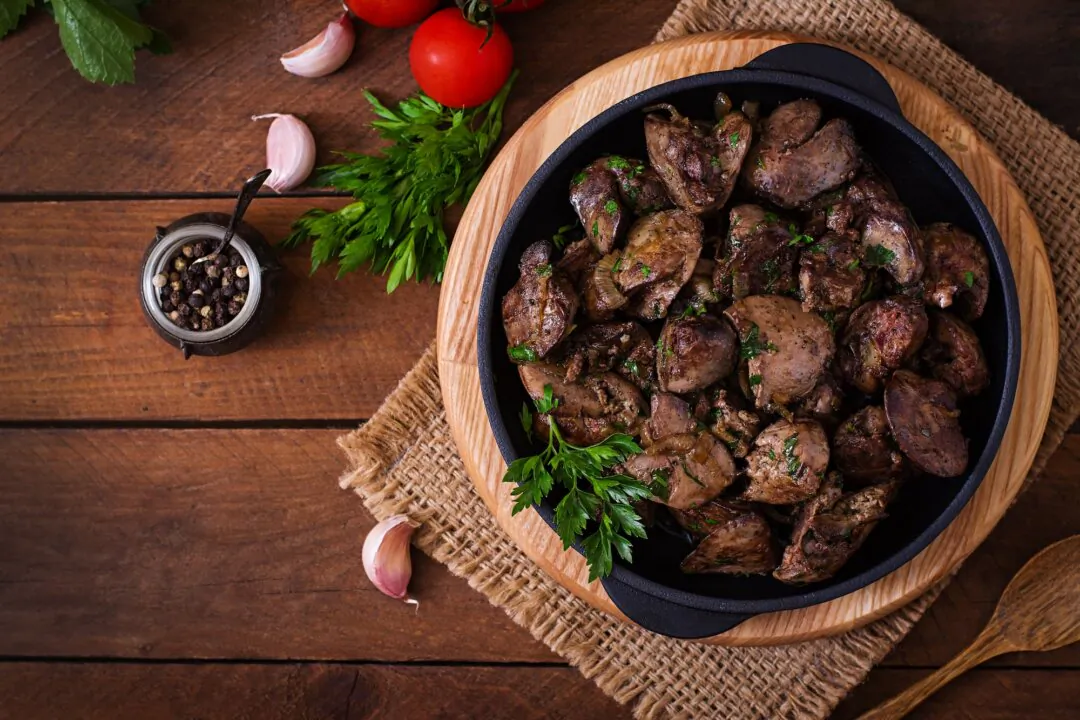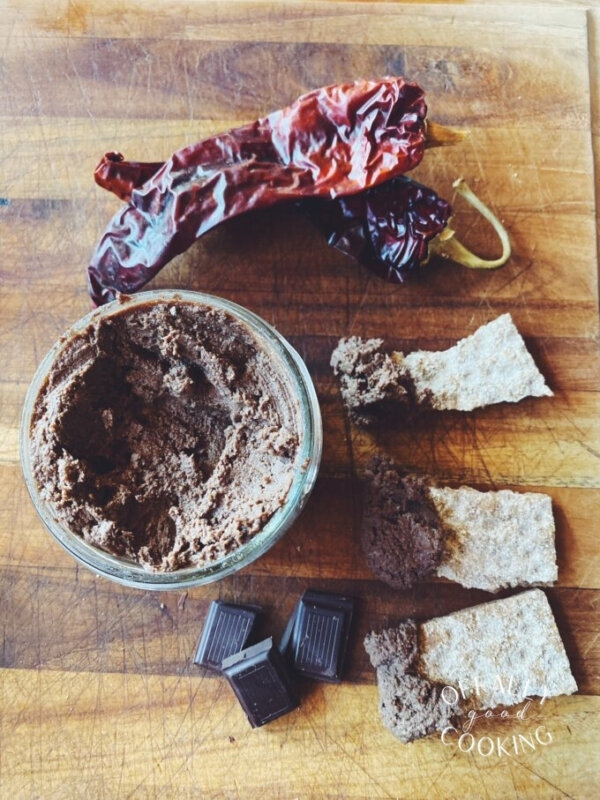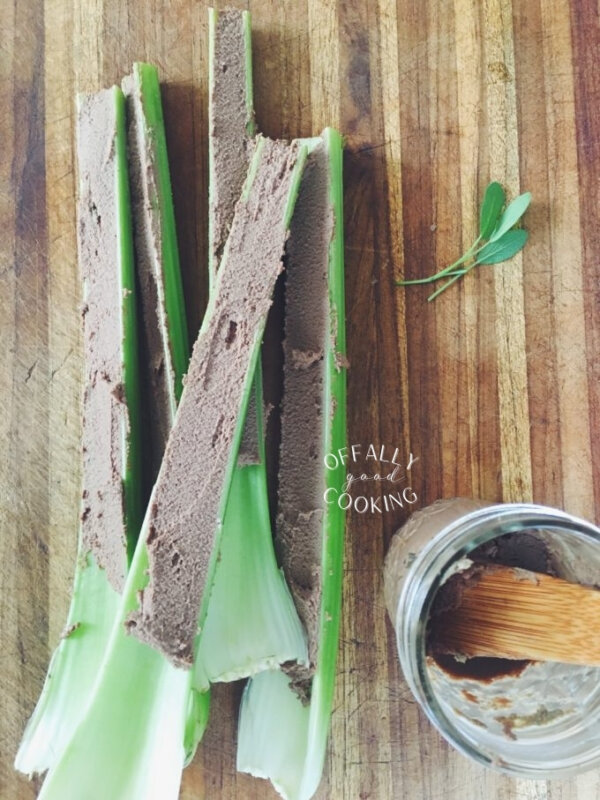Having nutrient-dense food on her family’s weekly menu allows Janine Farzin to relax about special treats that her kids get to enjoy from time to time.
That nutrient-dense food is animal organs, sometimes referred to as “offal.” Ms. Farzin first read about organ meat in “Nutrition and Physical Degeneration,” by Weston A. Price 12 years ago—it made her turn away from a mostly plant-based diet and become an expert in preparing liver and other oft-discarded animal parts for her husband and four children.
“These are the most important foods to nourish my family. These are the foods that make me feel like I can exhale when we are exposed to all the things we are exposed to—the junk at the kids’ soccer games, the packaged stuff everywhere,” she told The Epoch Times. “When we eat these organ meats every week, I know we have this strong foundation.”
Because of organ meat’s reputation for being a healing food, Ms. Farzin offers her organ meat dishes to nourish sick friends and family and to optimize digestion, skin, brain health, and more. In 2017, after sharing tips and advice with friends for years, she was inspired to write about her lifestyle in a blog she called “Offally Good Cooking.” It’s filled with recipes with organ meat as the main course.
Ms. Farzin’s mission is to show others that eating animal organs can improve just about any health condition, and it’s not that complicated to prepare enjoyable recipes with them.
Why Eat Organ Meats?
Two generations ago, it was common for families to eat organ meats. Consumer demand for choice cuts of meat and more plant-based eating, however, has turned this once-prized fare into a culinary oddity.
The fading popularity of organ meats has coincided with a similar decline in gut health. As many as 70 million Americans suffer from gastrointestinal (GI) diseases, and gut problems are disrupting the lives of 40 percent of the U.S. population, according to the American Gastroenterological Association.
Many of the vital nutrients found in organ meats can play a significant role in the optimal functionality of GI health. Liver has more nutrients than any other food, according to the Weston A. Price Foundation.
For many, adding organ meat into the diet could be more doable than the common medical advice to restrict foods. That’s because what one eats can help the gut overcome damage from antibiotics, stress, exercise, genetics, and more.
Everything we consume—including beverages, drugs, and supplements—influences the gut microbiota, the community of bacteria, viruses, fungi, and other microorganisms that help metabolize our foods and ultimately contribute to important bodily functions. One of those roles is fortifying the gut mucosal barrier.
Specific nutrients are closely associated with microbes that help with intestinal health. When we have vitamin deficiencies, our gut health suffers, according to a 2022 review article in Microorganisms.
B and A vitamins and choline are among the nutrients found in animal livers that are capable of bolstering digestive health. These micronutrients have important protective roles.
Fortifying Your Gut Wall
A long list of various gut bacteria synthesize B vitamins, so when there are deficiencies in the diet, it can impact health in a number of ways. Animal liver is particularly high in vitamins B2, B9, and B12.
Vitamins B12 and B2 are among the top six micronutrients in a serving of liver (one-quarter pound). Vitamin B12 in that serving offers 1,661 percent of recommended daily allowance (RDA); B2, 237 percent; and B9, 82 percent, according to Check Your Food, an interactive calculator based on English standards.
The U.S. Department of Agriculture website presents nutrients in measurements but doesn’t note RDA.
According to the 2022 Microorganisms review, vitamin B deficiencies may impact gut health in the following ways:
- Vitamin B2, which is converted into riboflavin in the body, helps with intestinal cell growth. Deficiencies are associated with slow cell division, which could slow down the mucosal layer in the gut from replenishing itself. While the gut lining is the fastest regenerating tissue in the body, slow cell growth can lead to increased intestinal permeability, associated with some digestive disorders.
- Vitamin B9, also known as folate, is responsible for cell survival rate with deficits significantly altering intestinal cells and increasing the risk of intestinal cancer. Folate is vital for regenerating the intestinal lining and helping to produce chemicals needed for brain function.
- Vitamin B12 is produced by about 20 percent of gut bacteria, and more than 80 percent of bacteria require it to perform metabolic functions. Vitamin B12 plays a role in microbiota composition, may lower inflammation, helps in red blood cell production, and supports the central nervous system.
Liver to Protect Your Liver
Beef liver and beef are top dietary sources of the essential nutrient choline, with 88 percent of the RDA. Choline can also be made by the liver—although not in sufficient amounts—and its deficiency is associated with liver disease, among other conditions such as cardiovascular disease, Type 2 diabetes, cognitive function issues, and a dysregulated gut.
Choline deficiency allows fat to build up in the liver, causing nonalcoholic fatty liver disease (NAFLD), a fast-growing form of liver disease affecting 25 percent of U.S. adults, according to the American Liver Foundation.
A 2018 article in the Journal of the American College of Nutrition found higher intake of choline in the U.S. diet was associated with a lower risk of developing NAFLD, as well as a favorable liver enzyme profile.
The composition of the gut microbiota might be the reason. A 2010 study published in Gastroenterology identified it as a potential predictor for developing NAFLD associated with choline deficiency.
An Oregon State University article on choline also noted its deficiency has been linked in animal studies to an increased probability of spontaneous liver cancer and sensitivity to cancer-causing chemicals.
“Yet, it is not known whether choline deficiency can increase the susceptibility to cancer in humans,” the article stated.
Immunity Building Blocks
Vitamin A is often considered one of the top benefits of eating liver, which offers 795 percent of the RDA. Vitamin A is also noted as the reason some medical sources advise against eating organ meat.
Once absorbed in the intestine, vitamin A is converted into various forms. Vitamin A is critical to gut immunity homeostasis, with the form retinoic acid coordinating the movement and function of immune cells.
Vitamin A helps to regulate the gut barrier by influencing gut microbial composition, including regulating antimicrobials. Some retinoids appear to have their own direct antibacterial properties, as well, according to a 2019 article in PLOS Pathogens.
However, too much vitamin A has been presumed to cause birth defects. Cleveland Clinic warns pregnant women to avoid it, and cautions that children should eat smaller servings than adults because they need less vitamin A.
The Weston A. Price Foundation says that much of the research that these warnings are based on involves synthetic forms of vitamin A. It urges its readers to consider only high-quality animal meats for sourcing liver.
Immune cells require vitamin A—available only through the diet—and the lack of it, particularly in children who also have low-fiber diets, could be responsible for the development of allergies. In fact, Monash University in Australia suggests that vitamin A deficiency is a bigger concern for children than adults.
“This may explain why the highest prevalence of allergies occurs in children and infants,” a news article on its website states.
The Weston A. Price Foundation offers readers a recipe for baby formula that includes cod liver oil, as well as recipes that include liver tonics for stressed-out adults.
How to Eat Organ Meat
Kat Owens, a certified functional nutritional therapy practitioner, acknowledges that she typically uses a meat grinder to portion organ meats into small servings that she throws into other dishes.
“I personally do not like the taste of organ meats like liver. I’ve tried,” she said. “When they’re mixed with the ground beef, you really can’t tell at all.”
Ms. Farzin said it can take 15 to 20 exposures to a food before the taste is tolerable. She suggests starting with very small servings and trying different recipes.
There’s a tradeoff with liver, too, she said, in that the flavor becomes more intense the longer that it’s cooked, which leads to a more meat-like texture. However, the flavor is mild when the liver is a bit more “jiggly.”
The biggest value is seeing how liver makes you feel, Ms. Farzin said.
“I didn’t know how unwell I was until I started eating these foods,” she said. “We think these things are so weird and gross, but they are prized all over the world.”
Ms. Owens said the most interesting thing about adding liver to the diet is noting how it might affect different people in unique ways.
“Every function in our body uses micronutrients and minerals to perform that function,” she said. “When we are getting really nutrient-dense food in our diet … we don’t even know what kind of improvements people are going to see sometimes.
“Whether it’s anxiety, digestive problems, [or] sleep. Sometimes, we don’t even know why they’re seeing these improvements.”
3 Easy and Elegant Liver Recipes
Wondering how to incorporate organ meats into your diet in an easy and palatable way? Ms. Farzon’s recipes, featured on her website, OffallyGoodCooking.com, take these nutrient-dense foods from beyond “palatable” to plain “delicious.”
The listed recipes are republished with permission from Janine Farzan.
Baked Liver and Breadcrumbs
Ingredients
For the main dish:
- 1 teaspoon butter
- 1 pound beef liver, trimmed of outer membrane and any tubules
- 6 slices bacon
- 1/2 cup broth
For the stuffing:
- approximately 3/4 cup breadcrumbs (or 3 slices bread, chopped and dried)
- 1/4 cup chopped parsley
- 1/2 shallot, chopped
- 1/2 teaspoon dried rosemary
- 1/2 cup broth
- 2 tablespoons butter, warmed
- 3/4 teaspoon salt
- 1/4 teaspoon pepper
Instructions
- Preheat oven to 350 F. In a baking casserole, rub the teaspoon of butter all over the bottom and sides of your casserole.
- Prepare the stuffing by mixing breadcrumbs, parsley, shallot, rosemary, broth, butter, salt, and pepper.
- Place the liver slices flat in the greased casserole. Cover with breadcrumbs, then sliced bacon, and finally spoon remaining broth over the top.
- Cover with parchment paper and bake in preheated oven for 27 minutes. Remove parchment, increase heat to broil, and return to oven for 2 to 3 minutes. Serve warm.
Chocolate Chili Liver Pâté
Ingredients
- 1 1/4 pounds beef liver (in slices)
- stick butter or a cup of lard, separated
- 3 tablespoons carob powder
- 3 tablespoons maple syrup
- 1/4 teaspoon nutmeg
- 1/4 teaspoon cayenne pepper
- 3/4 teaspoon allspice
- 1 3/4 teaspoons New Mexican chili powder
- 1 teaspoon salt
- 1/8 teaspoon black pepper
Instructions
- Peel off or trim skin from liver slices and remove any large tubules.
- Meanwhile, heat pan on medium-high and add first tablespoon of butter or lard. When hot, add liver and saute. Depending on thickness of slices, cook for about 2 minutes on first side and about 1 to 2 minutes on second side until rosy in the center. Do not overcook as liver will continue to heat/cook a bit when you blend it.
- Turn off the heat, add remaining butter or lard, and return pan to hot stovetop to slowly melt.
- While the butter is melting, let liver slices rest on cutting board for a moment, then cut into 1- to 2-inch pieces.
- Add liver cubes to food processor or blender along with all remaining ingredients—carob powder, maple syrup, nutmeg, allspice, chili powder, cayenne pepper, salt, black pepper, and melted butter. Blend until smooth.
Chicken Liver Pâté With Sausage Seasonings
Ingredients
- 1 pound chicken livers
- 1/2 cup lard, divided
- salt (1 heaping teaspoon of fine sea salt, or adjusted to taste)
- 1/2 teaspoon ground pepper
- 1 tablespoon fresh sage, chopped
- 1/4 teaspoon freshly grated nutmeg
- 1/4 teaspoon cayenne pepper
Instructions
- Clean up your chicken livers, cutting off any connective strips or dark spots, and roughly chop. You can be much quicker than usual if you plan to pass the puree through a sieve as described in Step 4 below.
- Sauté the chicken livers. Add 2 tablespoons lard to the pan (for each batch, if the livers don’t all fit in one pan). Heat on medium until lard is melted, then sauté the livers for about 2 to 3 minutes per side until they are a little browned but still pink in the middle. Pour all of this off into a food processor or blender jar.
- Return pan to the stove on low and add remaining lard. Meanwhile, as the lard melts, add salt, pepper, sage, nutmeg, and cayenne pepper and blend until smooth. When the remaining lard is melted, add it to the food processor/blender as well.
- Optional—Pour the mixture through a medium-mesh sieve over a bowl. Use the back of a ladle, moving in circles in the sieve to push the puree through. All the tangly bits and excess connective tissue will be caught up in the sieve. In the bowl, you will be left with an easy-to-eat smooth-as-can-be mousse.
- Taste for seasonings and then pour or spoon pate/mousse into jars. Cover each jar with a little piece of parchment or wax paper to keep it from oxidizing. Generously lick your spatula and other utensils before washing.






